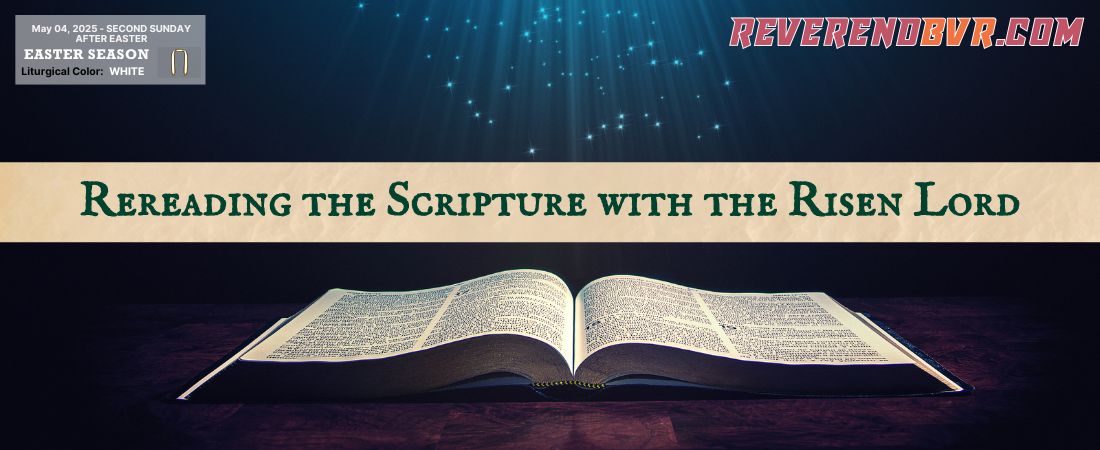Theme: Rereading the Scripture with the Risen Lord | Bible portions: 2 Chro.34:29-33; Ps. 19: 7-14; Acts 8:26-40 and Lk. 24:13-27
May 4, 2025 – Second Sunday after Easter
Introduction: The Risen Lord as Our Exegete (ἐξηγεῖσθαι – exēgeisthai, means to lead out, explain, interpret – Jesus as the one who draws out the meaning of Scripture.)
The Resurrection of Christ is not simply the climax of the Gospel; it is also the moment that reorients the entire biblical narrative. As St. Luke recounts in the profound Emmaus encounter, the Risen Lord Himself becomes the interpreter of Scripture, revealing that “beginning with Moses and all the Prophets, he explained to them what was said in all the Scriptures concerning himself” (Luke 24:27, NIV). This is no small interpretative move—it is a seismic reorientation. It teaches us not merely how to read the Bible, but with whom we are to read it.
We are invited, especially in this Easter season, to reread the Scriptures—not as dusty historical texts but as living words that, when read with the Risen Christ, reveal the mystery of salvation. Let us, therefore, explore what it means to reread the Scriptures with the Risen Lord and how this encounter shapes our theology, discipleship, and daily lives.
1. Rereading for Renewal: Josiah and the Book of the Covenant (2 Chronicles 34:29–33)
The story of King Josiah offers a dramatic illustration of the transformative power of rediscovered Scripture. Upon hearing the words of the Book of the Law, Josiah tore his robes in repentance—a sign of sincere contrition and urgent action. But Josiah does not stop at private piety. He gathers “all the people from the least to the greatest” (v. 30) and publicly renews the covenant.
This act of collective rereading leads to national reform. Idols are destroyed, hearts are turned, and lives are renewed. The Word is not simply read—it is lived. In an age of distraction and spiritual apathy, this passage calls us back to a corporate rediscovery of the Scriptures, not merely to learn information, but to enter into transformation.
Reading the Bible in the presence of the Risen Lord is not a scholastic exercise. It is a covenantal act that renews our identity as the people of God. As Psalm 19:7–10 testifies, “The law of the Lord is perfect, refreshing the soul … more precious than gold … sweeter than honey.” The Word of God, when encountered with the Living Word, revives, reforms, and redirects.
2. Rereading to Recognize Christ: The Emmaus Encounter (Luke 24:13–27)
The disciples walking to Emmaus had all the data—they had witnessed Jesus’ life and heard reports of the empty tomb—but they lacked interpretation. It is only when Jesus “opened the Scriptures to them” that they began to understand, and even then, recognition came fully only in the breaking of the bread (Luke 24:35).
Theologically, this passage is an anchor for the Church’s post-resurrection hermeneutic. The Scriptures are not self-interpreting in any neutral sense. They are Christocentric. As Fr. John Behr writes, it is not simply that Jesus fulfills Scripture, but that Scripture finds its true meaning in Jesus. The Law, the Prophets, the Psalms—they are not just texts to be understood, but testimonies to be revealed in the light of Christ.
This is why the Church insists that Scripture must be read with faith, tradition, and above all, in the presence of the Risen Christ. Without this interpretative key, Scripture can be misunderstood or even misused. But when Christ interprets the Word to us, “our hearts burn within us” (Luke 24:32), and our eyes are opened.
3. Rereading That Leads to Faith: Philip and the Ethiopian Eunuch (Acts 8:26–40)
This passage beautifully illustrates how the Word, when illumined by the Spirit and explained through faithful witness, brings forth saving faith. The Ethiopian eunuch is a seeker—he reads Isaiah, but he is confused. “How can I [understand], unless someone explains it to me?” (Acts 8:31). Philip’s Spirit-led guidance exemplifies the Church’s role in proclaiming and interpreting the Scriptures in the light of Christ.
This is not merely a story about evangelism; it is a story about hermeneutics. The eunuch does not ask about the abstract meaning of Isaiah 53, but “of whom does the prophet speak?” (v. 34). That question turns Scripture from a historical document into a living Word centered in Christ. Philip answers with the Gospel: “Then Philip began with that very passage of Scripture and told him the good news about Jesus” (v. 35).
This is the heart of Christian exegesis: Scripture speaks of Christ, and when rightly interpreted, it brings not only understanding but new birth. The eunuch, once confused, leaves the scene rejoicing, baptized into Christ and into a new identity (v. 39).
4. The Living Hermeneutic: Christ the Word Interprets the Words
Modern biblical scholarship often seeks the “original meaning” of texts through historical-critical methods. While this has academic value, it must be complemented by the Church’s deeper hermeneutic: a reading “in the Spirit,” under the guidance of the Risen Christ.
The early Church Fathers understood this well. St. Irenaeus, for example, declared that Christ is the “treasure hidden in the field” (Matt. 13:44), the one found throughout the Scriptures, revealed fully only after the Resurrection. As Fr. Behr explains, “It is not so much Scripture that is being exegeted, but rather Christ who is being interpreted by recourse to the Scriptures.”
This shift is not anti-intellectual; it is sacramental. Christ is the Logos—the Living Word—and all Scripture finds coherence in Him (John 5:39). The Church’s mission, therefore, is not simply to explain the Bible, but to bear witness to the Living Word through Scripture. When we read the Bible with Jesus, we do not merely gain information—we are invited into communion.
5. Practical Implications: Living the Word with the Risen Christ
How then shall we live, in light of this profound encounter?
- Read Scripture daily, but always with the Risen Lord as our teacher. Pray before reading. Invite Christ to walk with you through the text.
- Be open to transformation, not just insight. Scripture is not a mirror to admire ourselves, but a sword to cut away what is false and awaken what is holy (Heb. 4:12).
- Reread the Scripture in community, following the example of Josiah. Read together in churches, homes, and study groups. The Spirit often speaks through the gathered body.
- Allow Scripture to lead us to action. As with the Ethiopian eunuch, true understanding leads to faith, baptism, and joy-filled mission.
- Finally, Recognize Christ in Word and Sacrament, in Scripture and in the breaking of the bread. These are the two pillars of our encounter with the risen Christ.
6.Conclusion: The Bible as the Risen Lord’s Voice
The Bible is not a closed book, nor is it merely a literary artifact. It is the voice of the Risen One, speaking to us today. As we walk the roads of our lives—perhaps confused, disappointed, or disillusioned—may we discover that Jesus walks with us, opening the Scriptures and opening our hearts.
Let us therefore read, reread, reflect, relate, refer, reason, and record—not as scholars alone, but as disciples. Let us read with the Risen Lord, and allow Him to transform our understanding, our hearts, and our world.
7.Closing Prayer
Lord Jesus Christ, Word made flesh and Risen Lord,
You walked with your disciples on the road, Opening the Scriptures and their hearts. Walk with us, O Lord, as we read your Word. Open our eyes to see you in every page, Open our ears to hear your voice in every verse, And open our hearts to be transformed by your love. Help us to reread your Word with you as our teacher, To walk in your ways, and to live in your light. May our hearts burn within us, And may our lives proclaim your resurrection power. Amen.
Table for a quick theological summary on the Theme: Rereading Scripture with the Risen Lord
| Section | Scripture | Key Insight | Christological Lens | Practical Application |
| 1. Rereading for Renewal | 2 Chronicles 34:29–33 Psalm 19:7–10 | Rediscovery of the Word leads to covenantal renewal | The Word revives when read with reverence and reform | Read Scripture communally for transformation |
| 2. Recognizing Christ | Luke 24:13–35 | Jesus reinterprets the Scriptures in light of Himself | Christ is the interpretive key to all Scripture | Read with faith, expect Christ’s presence |
| 3. Reading that Leads to Faith | Acts 8:26–40 Isaiah 53 | The Word explained brings saving faith | Scripture testifies to Christ crucified and risen | Engage seekers with Christ-centered interpretation |
| 4. Living Hermeneutic | John 5:39 Matthew 13:44 | Scripture coheres in the Living Word | Christ is not just in Scripture—He is Scripture | Let the Risen Lord interpret your reading life |
| 5. Practical Implications | Hebrews 4:12 Luke 24:32 | Reading with Christ changes hearts and habits | The Word cuts, heals, and sends us forth | Read, reread, and respond in faith and community |
Bibliography
- The Holy Bible Reference Verses- 2 Chro.34:29-33; Ps. 19: 7-14; Acts 8:26-40 and Lk. 24:13-27
- Behr, John. The Mystery of Christ: Life in Death. St. Vladimir’s Seminary Press, 2006.
- Irenaeus. Against Heresies. Translated by Dominic J. Unger. Paulist Press, 1992.
- Wright, N. T. The Resurrection of the Son of God. Fortress Press, 2003.
- Brown, Raymond E. The Birth of the Messiah. Doubleday, 1993.
- Calvin, John. Commentaries on the Acts of the Apostles.
- Augustine. Confessions and On Christian Doctrine.
- Barbour, Ian. Myths, Models and Paradigms. Harper & Row, 1974.
For more sermons and biblical reflections, visit:
🌐 www.reverendbvr.com/sermons

